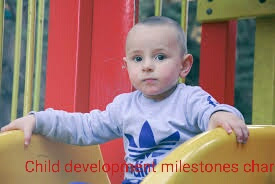Child development milestones chart.
There is an inexpressible joy in watching a child grow and develop. The entire family enjoys the child’s day to day achievements, and takes great pleasure in describing these in intricate details. Achild develops gradually, in an almost programmed manner in accordance with Nature. These developmental milestones are described in this chapter. The changes are not visible overnight, but gradual progress is obvious over a period. If, for any reason, a particular milestone is not achieved within the stipulated time, (for example, the child is unable to hold up its head, turn over, or crawl within the given period), expert medical advice should be sought immediately.
A new-born child normally weighs between 2.5 and 3.5 kilograms. The child will normally lose a little weight in its first week, but rapidly put it back on in the second week, and continue to gain weight very quickly over the first year. After the first year its weight gain will become more gradual. Although there may be variations on weight gain depending on diet and the baby’s constitution, a child will gain approximately half a kilogram a month for the first year. A healthy Indian child will weigh between 2.5 and 3 kilograms at birth. Its weight will double at the age of six months, be three times at one year, 4 times at 2 years and 5 times at 3 years of age. Between the ages of 3 and 7 years the child will gain about 2 kg per year. From the age of 7 until puberty the child will gain about 3 kg per year.
On average, the weight of a 3 year old will be 15 kg, of a 5 year old will be 18 kg and a 7 year old will be 21kg. Many parents worry unnecessarily, if their child is not chubby. If the baby’s development is normal, if it plays happily, eats and sleeps well, and if its physical and mental milestones are within the norm, there is no reason to be concerned. However, if the baby does not gain weight for 2-3 months and is irritable, does not feed properly, or is inordinately plump, then expert advice should be sought.
Turning The Head, Grasping with Hands : By the fourth month, the baby begins to turn its head in the direction of any sound or noise nearby, and tries to grasp things with its hands. Gradually, it is able to hold small toys easily. The child also begins to articulate (i.e. make sounds when it is happy), and is able to turn on its abdomen.
A new-born child normally weighs between 2.5 and 3.5 kilograms. The child will normally lose a little weight in its first week, but rapidly put it back on in the second week, and continue to gain weight very quickly over the first year. After the first year its weight gain will become more gradual. Although there may be variations on weight gain depending on diet and the baby’s constitution, a child will gain approximately half a kilogram a month for the first year. A healthy Indian child will weigh between 2.5 and 3 kilograms at birth. Its weight will double at the age of six months, be three times at one year, 4 times at 2 years and 5 times at 3 years of age. Between the ages of 3 and 7 years the child will gain about 2 kg per year. From the age of 7 until puberty the child will gain about 3 kg per year.
On average, the weight of a 3 year old will be 15 kg, of a 5 year old will be 18 kg and a 7 year old will be 21kg. Many parents worry unnecessarily, if their child is not chubby. If the baby’s development is normal, if it plays happily, eats and sleeps well, and if its physical and mental milestones are within the norm, there is no reason to be concerned. However, if the baby does not gain weight for 2-3 months and is irritable, does not feed properly, or is inordinately plump, then expert advice should be sought.
Holding Up The Head :
The first important milestone is the baby being able to hold up its own head. This should be achieved by the age of 21/2 to 3 months. The baby should be able to hold its head upright even when it is held on the shoulder or being lifted up from a lying position. Its gaze should also have stabilized by this age, so that it can follow the movements of objects in front of it.Turning On The Side :
A three-month-old baby should be able to turn over on its side independently. It should also begin to respond to those around it, and, for example, should show some facial reactions when spoken to. By this time, the child can usually recognize all members of the family.Turning The Head, Grasping with Hands : By the fourth month, the baby begins to turn its head in the direction of any sound or noise nearby, and tries to grasp things with its hands. Gradually, it is able to hold small toys easily. The child also begins to articulate (i.e. make sounds when it is happy), and is able to turn on its abdomen.








Leave a Comment